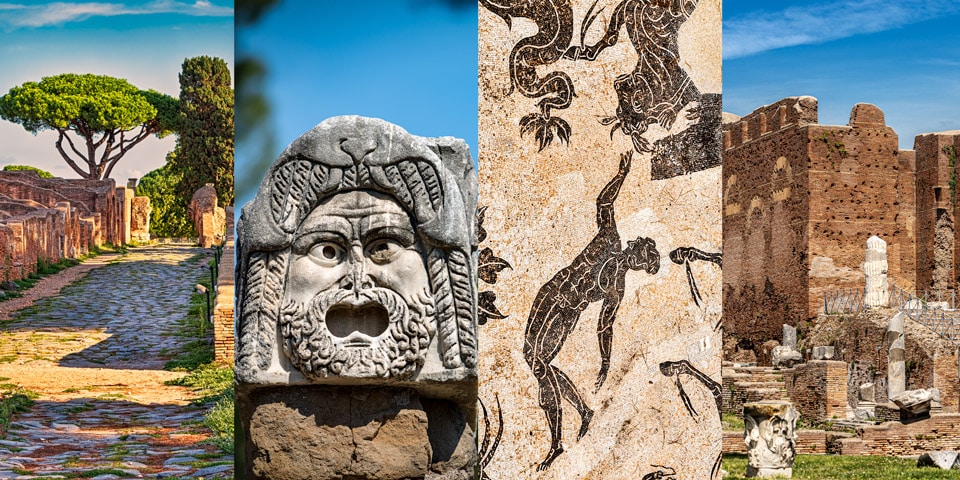

24828 views
Written by: Kate Zusmann

| Tickets |
Buy tickets online: |
|---|---|
| Opening Hours |
Monday:
-
Tuesday:
-
Wednesday:
-
Thursday:
-
Friday:
-
Saturday:
-
|
| Recommended tour | |
| Address | Viale dei Romagnoli, 717, Roma |
| Website | www.ostiaantica.beniculturali.it |
Ostia Antica is a large archeological site near Rome on the Tiber River. It had the status of Rome’s harbor or port city during ancient times. However, after the Roman Empire fell, the city became abandoned and remained untouched and preserved for centuries. Today, the Roman ruins of Ostia Antica, which served as the old city’s seaport, attract visitors worldwide.
Contents
ToggleBelow are 11 interesting and unusual historical facts about Ancient Ostia. Memorize a few and surprise your friends while visiting the archaeological site.
Ostia was founded around 620 B.C.
In 400 B.C., Rome conquered the city and made it a naval base. By 150 A.D., Ostia served as a commercial Rome’s ancient Port. However, with the fall of Rome, the Port was abandoned, and the harbor silted up over time.
A small museum in Ostia offers statuaries of tangled wrestlers kissing cupids, works are from the 2nd to 3rd centuries of and gods most of the art and m A.D. Most of the masterpieces are inspired by Greek originals, and many of them are from different religions. Since Ostia was a port, it accommodated people from all over the world.
Nowadays, you can walk on a vast territory full of ruins and unique buildings that went through centuries. The main street, Decumanus Maximus, was once full of carrucas, the four-wheeled carts that ferried merchandise and luggage between Rome and Ostia. Moreover, two-wheeled cisia was used as public transportation for commuters.
One of the main sites to see is Ostia’s amphitheater.
Founded in 12 B.C., it is a magnificent and well-preserved building, which fascinates with its size and beauty. Behind the theater is the Forum of Corporations, which served as the building with the offices of sixty-four maritime companies. You will still find mosaic names, pictures on the ground in front of each office, and a covered corridor.
In the age of Emperor Claudius, the place was raised by a second level to create the seats of the collegia, which is the association of trades for business making. The Temple of Ceres is in the middle of the Forum. Also, there are the Baths of Neptune with mosaics of the sea god. Additionally, the site is right near the modern café, where you can book a tour.
Don’t forget about the high podium of the Collegiate Temple. Interestingly, it was a social club for men of the poorer classes, where they afforded themselves a kind of a banquet while the rich could afford it daily. The dinners began at 3 pm and lasted until the sun’s rise.
Women weren’t invited to the banquets.
Moreover, enslaved people were doing washings in the small terracotta tubs on the brick counters. Their heads were shaved as a distinguishing sign. The laundry is located near the public baths.
Ostia reached 50,000 inhabitants during its development, but around the third century A.D., a deep crisis decreased trade and commerce. Consequently, part of the inhabitants left the city. After the fifth century A.D., there economic recovery of the city led to the move of all commercial and administrative activities to the Port of Trajan. In addition, the Port was highly protected from storms and enemy incursions.
At the center of the square, the temple was built over a podium in the age of Emperor Domitian, among gardens and open spaces decorated with statues.
The three Masks turned to the stage of the Theater.
Public transport is the most economical way to get to the archaeological site of Ostia Antica from Rome. Since Ostia is part of the metropolis, a 1.5-euro city ticket is enough for the trip, which is valid for 100 minutes.
First, you must get to Pyramide metro station (blue line B). Then get to Porta San Paolo and take the first train on the Roma-Lido di Ostia line, stopping at Ostia Antica. Trains leave every 20 minutes, and travel time is about 30 minutes.
See detailed instructions with photos on how to get to Ostia from Rome by train.
A private transfer from Rome is the most convenient way to get to Ostia. You will be picked up right at the hotel and taken directly to the entrance to the archaeological complex. A round trip will cost 120 euros for a group of up to 4 people. The trip in a premium-class car with air conditioning will take about 35-40 minutes. To book a trip, I recommend contacting the most punctual transfer service in Rome, Sergio & Partners.
Ostia Antica and Pompeii are remarkable archaeological sites offering unique insights into ancient Roman life. Choosing which one to visit from Rome depends on your interests, time constraints, and travel preferences.
Ostia Antica, located just 15 miles (25 km) southwest of Rome, is more easily accessible and requires less travel time than Pompeii. A visit to Ostia Antica can be comfortably done as a half-day trip from Rome, making it an excellent choice for those with limited time or who prefer a shorter journey. As Rome’s ancient harbor city, Ostia Antica boasts well-preserved ruins, including an amphitheater, baths, and intricate mosaics. The site is generally less crowded than Pompeii, allowing for a more relaxed and intimate exploration of the ruins.
Pompeii, on the other hand, is situated about 150 miles (240 km) southeast of Rome, near Naples. A visit to Pompeii from Rome typically involves a full-day trip, as the journey by train or car takes around 3 to 4 hours each way. Pompeii is renowned for its dramatic history, having been buried under volcanic ash during the eruption of Mount Vesuvius in 79 AD. The site offers a haunting yet fascinating glimpse into the lives of the people who lived there, with many buildings, frescoes, and artifacts preserved in remarkable detail. Pompeii is larger and more famous than Ostia Antica, often attracting larger crowds of tourists.
In summary, if you have limited time or prefer a more relaxed and convenient experience, Ostia Antica is an excellent choice for a visit from Rome. However, if you are intrigued by Pompeii’s dramatic history and don’t mind dedicating a full day to travel and exploration, Pompeii offers a unique and unforgettable experience. Both sites provide a fascinating look into ancient Roman life, and the choice ultimately depends on your personal preferences and travel itinerary.
Read how to get to Naples from Rome and where to travel from Rome.
Author: Kate Zusmann
This website uses cookies. For more info read the cookies policy
Rome.us © 2025. Created with love by Roman experts and guides.